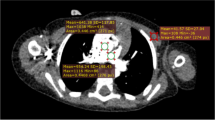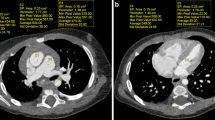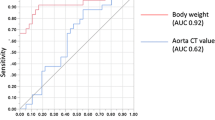Abstract
To retrospectively evaluate the image quality of CT angiography (CTA) reconstructed by model-based iterative reconstruction (MBIR) and to compare this with images obtained by filtered back projection (FBP) and adaptive statistical iterative reconstruction (ASIR) in newborns and infants with congenital heart disease (CHD). Thirty-seven children (age 4.8 ± 3.7 months; weight 4.79 ± 0.47 kg) with suspected CHD underwent CTA on a 64detector MDCT without ECG gating (80 kVp, 40 mA using tube current modulation). Total dose length product was recorded in all patients. Images were reconstructed using FBP, ASIR, and MBIR. Objective image qualities (density, noise) were measured in the great vessels and heart chambers. The contrast-to-noise ratio (CNR) was calculated by measuring the density and noise of myocardial walls. Two radiologists evaluated images for subjective noise, diagnostic confidence, and sharpness at the level prior to the first branch of the main pulmonary artery. Images were compared with respect to reconstruction method, and reconstruction times were measured. Images from all patients were diagnostic, and the effective dose was 0.22 mSv. The objective image noise of MBIR was significantly lower than those of FBP and ASIR in the great vessels and heart chambers (P < 0.05); however, with respect to attenuations in the four chambers, ascending aorta, descending aorta, and pulmonary trunk, no statistically significant difference was observed among the three methods (P > 0.05). Mean CNR values were 8.73 for FBP, 14.54 for ASIR, and 22.95 for MBIR. In addition, the subjective image noise of MBIR was significantly lower than those of the others (P < 0.01). Furthermore, while FBP had the highest score for image sharpness, ASIR had the highest score for diagnostic confidence (P < 0.05), and mean reconstruction times were 5.1 ± 2.3 s for FBP and ASIR and 15.1 ± 2.4 min for MBIR. While CTA with MBIR in newborns and infants with CHD can reduce image noise and improve CNR more than other methods, it is more time-consuming than the other methods.


Similar content being viewed by others
References
Brenner DJ, Hall EJ (2007) Computed tomography–an increasing source of radiation exposure. N Engl J Med 357(22):2277–2284
Brody AS, Frush DP, Huda W et al (2007) Radiation risk to children from computed tomography. Pediatrics 120(3):677–682
Frush DP (2004) Review of radiation issues for computed tomography. Semin Ultrasound CT MR 25(1):17–24
National Research Council (2006) Health risks from exposure to low levels of ionizing radiation; BEIR VII Phase 2. The National Academies Press, Washington
Brenner D, Elliston C, Hall E et al (2001) Estimated risks of radiation-induced fatal cancer from pediatric CT. Am J Roentgenol 176(2):289–296
Pearce MS, Salotti JA, Little MP et al (2012) Radiation exposure from CT scans in childhood and subsequent risk of leukaemia and brain tumours: a retrospective cohort study. Lancet 380(9840):499–505
Goske MJ, Applegate KE, Boylan J et al (2008) The Image Gently campaign: working together to change practice. Am J Roentgenol 190(2):273–274
Kalra MK, Maher MM, Toth TL et al (2004) Strategies for CT radiation dose optimization. Radiology 230(3):619–628
Heyer CM, Mohr PS, Lemburg SP et al (2007) Image quality and radiation exposure at pulmonary CT angiography with 100- or 120-kVp protocol: prospective randomized study. Radiology 245(2):577–583
Diel J, Perlmutter S, Venkataramanan N et al (2000) Unenhanced helical CT using increased pitch for suspected renal colic: an effective technique for radiation dose reduction? J Comput Assist Tomogr 24(5):795–801
Kalra MK, Maher MM, Sahani DV et al (2003) Low-dose CT of the abdomen: evaluation of image improvement with use of noise reduction filters pilot study. Radiology 228(1):251–256
Kalra MK, Woisetschlager M, Dahlstrom N et al (2012) Radiation dose reduction with Sinogram Affirmed Iterative Reconstruction technique for abdominal computed tomography. J Comput Assist Tomogr 36(3):339–346
Thibault JB, Sauer KD, Bouman CA et al (2007) A three-dimensional statistical approach to improved image quality for multislice helical CT. Med Phys 34(11):4526–4544
Strub WM, Weiss KL, Sun D (2007) Hybrid reconstruction kernel: optimized chest CT. Am J Roentgenol 189(2):W115–W116
Husarik DB, Marin D, Samei E et al (2012) Radiation dose reduction in abdominal computed tomography during the late hepatic arterial phase using a model-based iterative reconstruction algorithm: how low can we go? Invest Radiol 47(8):468–474
Mieville FA, Gudinchet F, Brunelle F et al (2013) Iterative reconstruction methods in two different MDCT scanners: physical metrics and 4-alternative forced-choice detectability experiments—a phantom approach. Phys Med 29(1):99–110
Pickhardt PJ, Lubner MG, Kim DH et al (2012) Abdominal CT with model-based iterative reconstruction (MBIR): initial results of a prospective trial comparing ultralow-dose with standard-dose imaging. Am J Roentgenol 199(6):1266–1274
Katsura M, Matsuda I, Akahane M et al (2012) Model-based iterative reconstruction technique for radiation dose reduction in chest CT: comparison with the adaptive statistical iterative reconstruction technique. Eur Radiol 22(8):1613–1623
Yamada Y, Jinzaki M, Tanami Y et al (2012) Model-based iterative reconstruction technique for ultralow-dose computed tomography of the lung: a pilot study. Invest Radiol 47(8):482–489
Han BK, Lindberg J, Grant K et al (2011) Accuracy and safety of high pitch computed tomography imaging in young children with complex congenital heart disease. Am J Cardiol 107(10):1541–1546
Leschka S, Oechslin E, Husmann L et al (2007) Pre- and postoperative evaluation of congenital heart disease in children and adults with 64-section CT. Radiographics 27(3):829–846
Hara AK, Paden RG, Silva AC et al (2009) Iterative reconstruction technique for reducing body radiation dose at CT: feasibility study. Am J Roentgenol 193(3):764–771
Siegel MJ, Bhalla S, Gutierrez FR et al (2005) MDCT of postoperative anatomy and complications in adults with cyanotic heart disease. Am J Roentgenol 184(1):241–247
Goo HW (2012) CT radiation dose optimization and estimation: an update for radiologists. Korean J Radiol 13(1):1–11
Deak PD, Smal Y, Kalender WA (2010) Multisection CT protocols: sex- and age-specific conversion factors used to determine effective dose from dose-length product. Radiology 257(1):158–166
Smith EA, Dillman JR, Goodsitt MM et al (2014) Model-based iterative reconstruction: effect on patient radiation dose and image quality in pediatric body CT. Radiology 270(2):526–534
Shuman WP, Green DE, Busey JM et al (2013) Model-based iterative reconstruction versus adaptive statistical iterative reconstruction and filtered back projection in liver 64-MDCT: focal lesion detection, lesion conspicuity, and image noise. Am J Roentgenol 200(5):1071–1076
Chang W, Lee JM, Lee K et al (2013) Assessment of a model-based, iterative reconstruction algorithm (MBIR) regarding image quality and dose reduction in liver computed tomography. Invest Radiol 48(8):598–606
Karambatsakidou A, Sahlgren B, Hansson B et al (2009) Effective dose conversion factors in paediatric interventional cardiology. Br J Radiol 82(981):748–755
Einstein AJ, Moser KW, Thompson RC et al (2007) Radiation dose to patients from cardiac diagnostic imaging. Circulation 116(11):1290–1305
Cornfeld D, Israel G, Detroy E et al (2011) Impact of Adaptive Statistical Iterative Reconstruction (ASIR) on radiation dose and image quality in aortic dissection studies: a qualitative and quantitative analysis. Am J Roentgenol 196(3):W336–W340
Acknowledgments
This study was supported by a grant from Dongkook Pharmaceutical.
Conflict of interest
None.
Author information
Authors and Affiliations
Corresponding author
Rights and permissions
About this article
Cite this article
Son, S.S., Choo, K.S., Jeon, U.B. et al. Image quality of CT angiography with model-based iterative reconstruction in young children with congenital heart disease: comparison with filtered back projection and adaptive statistical iterative reconstruction. Int J Cardiovasc Imaging 31 (Suppl 1), 31–38 (2015). https://doi.org/10.1007/s10554-014-0570-1
Received:
Accepted:
Published:
Issue Date:
DOI: https://doi.org/10.1007/s10554-014-0570-1




